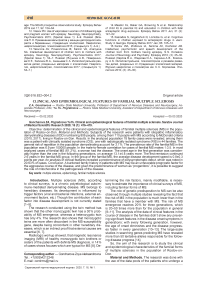Clinical and epidemiological features of familial multiple sclerosis
Автор: Goncharova Z.A., Pogrebnova Yu.yu.
Журнал: Саратовский научно-медицинский журнал @ssmj
Рубрика: Нервные болезни
Статья в выпуске: 1 т.16, 2020 года.
Бесплатный доступ
Objective: determination of the clinical and epidemiological features of familial multiple sclerosis (MS) in the population of Rostov-on-Don. Material and Methods. Subjects of the research were patients with idiopathic inflammatory demyelinating diseases (IIDD) numbering 806 people, among them 710 people with MS according to McDonald criteria (2010, 2017), living in Rostov-on-Don. Results. In the analyzed population 78 family cases were revealed; among them was a patient with clinically isolated syndrome (CIS), one with radiologically isolated syndrome (RIS) in 44 families. The general risk of repetition in the population demyelinating account for 3.7%. The prevalence rate of the familial MS in the population was 6.9 per 100000 people. In the male-to-female correlation for cases of familial MS makes 1:3.5. In most analyzed cases of familial MS (61.2%), a woman had the disease. The onset age in the first generation was considerably higher than the one in the following generations, on average 13.1±4.8 years more. The first remission continued 2.6 years in the familial MS group. In the group of the familial MS, the average disease development speed is 0.8±0.3 points per year. An analysis of clinical features revealed a predominance of polysymptomatic debut, which was noted in 20.63% of cases. Conclusion. A burdened family history in patients with MS may be an unfavorable prognostic factor for the aggressive course of the disease, and given the predominance of women as “progenitors”, it is possible to suggest the role of mitochondria in the pathogenesis of the disease.
Multiple sclerosis, epidemiology, familial multiple sclerosis
Короткий адрес: https://sciup.org/149135542
IDR: 149135542 | УДК: 616.832-004.2
Список литературы Clinical and epidemiological features of familial multiple sclerosis
- Gusev EI, Demina TL, Boyko AN. Multiple sclerosis. Moscow: Oil and Gas, 1997; 430 p. Russian (Гусев Е. И., Демина Т. Л., Бойко А. Н. Рассеянный склероз. М.: Нефть-газ, 1997; 430 с.).
- Epidemiological research of multiple sclerosis: Method. Recommendations of Healthcare Ministry of Russia №2003/82. Moscow, 2003; 80 p. Russian (Эпидемиологические исследования рассеянного склероза: методические рекомендации Министерства здравоохранения РФ №2003/82. М., 2003; 80 с.).
- Gusev EI, Zavalishin IA, Boyko AN. Multiple sclerosis and other demyelinating diseases. Moscow: Miklosh, 2004; 528 p. Russian (Гусев Е. И., Завалишин И. А., Бойко А. Н. Рассеянный склероз и другие демиелинизирующие заболевания. М.: Миклош, 2004; 528 с.).
- Zavalishin IA. Modern view of multiple sclerosis etiology. Journal of Neurology and Psychiatry 1990; (2): 3-8. Russian (Завалишин И. А. Современные представления об этиологии рассеянного склероза. Журнал неврологии и психиатрии 1990; (2): 3-8).
- Lauer K. The risk of multiple sclerosis in the USA in relation to socio-geographic features: A factor-analytic study. Journal of Clinical Epidemiology1994; 47 (1): 43-8.
- Criswell L, Pfeiffer K, Lum R, et al. Analysis of Families in the Multiple Autoimmune Disease Genetics Consortium (MADGC) Collection: the PTPN22620W Allele Associates with Multiple Autoimmune Phenotypes. The American Journal of Human Genetics 2005; 76 (4): 561-71.
- Ristori G, Cannoni S, Stazi M, et al. Multiple sclerosis in twins from continental Italy and Sardinia: A nationwide study. Annals of Neurology 2005; 59 (1): 27-34.
- Willer C, Dyment D, Risch N, et al. Twin concordance and sibling recurrence rates in multiple sclerosis. Proceedings of the National Academy of Sciences 2003; 100 (22): 12877-82.
- Farrall M. Mapping genetic susceptibility to multiple sclerosis. The Lancet 1996; 348 (9043): 1674-5.
- Goncharova ZA, Balyazin VA, Sekhveyl SM, et al. Clinical and epidemiological features of multiple sclerosis in children of the Rostov region. Clinical Practice in Pediatrics 2011; (6): 4750. Russian (Гончарова 3. А., Балязин В. А., Сехвейл С. М. и др. Клинико-эпидемиологические особенности рассеянного склероза у детей Ростовской области. Вопросы практической педиатрии 2011; (6): 47-50).
- Goncharova ZA. Clinic and epidemiology characteristic of the multiple sclerosis: prospective 20-years research: DSc abstract. Ivanovo, 2013; 40 p. Russian (Гончарова З. А. Клини-ко-эпидемиологическая характеристика рассеянного склероза: проспективное 20-летнее исследование: автореф. дис.... д-ра мед. наук. Иваново, 2013; 40 с.).
- Goncharova ZA, Fomina-Chertousova MA. Family cases of multiple sclerosis in a population of patients in the Rostov region. NeuroImmunology 2007; 5 (2): 80-1. Russian (Гончарова З. А., Фомина-Чертоусова М. А. Семейные случаи рассеянного склероза в популяции больных Ростовской области. Нейроиммунология 2007; 5 (2): 80-1).
- Sadovnick A, Yee I, Guimond C, et al. Age of onset in concordant twins and other relative pairs with multiple sclerosis. American Journal of Epidemiology 2009; 170 (3): 289-96.
- IMSGC. Evidence for Polygenic Susceptibility to Multiple Sclerosis: The Shape of Things to Come. The American Journal of Human Genetics 2010; 86 (4): 621-25.
- Alifirova VM, Titova MA, Terskikh EV, et al. Familial multiple sclerosis in the Tomsk region. S. S. Korsakov Journal of Neurology and Psychiatry 2016; 116 (10): 6-9. Russian (Семейный рассеянный склероз в Томской области. Журнал неврологии и психиатрии им. С. С. Корсакова 2016; 116 (10): 6-9).
- Hensiek A. HLA-DR 15 is associated with female sex and younger age at diagnosis in multiple sclerosis. Journal of Neurology, Neurosurgery & Psychiatry 2002; 72 (2): 84-187.
- Masterman T, Ligers A, Olsson T, et al. HLA- DR15 is associated with lower age at onset in multiple sclerosis. Annals of Neurology 2000; 48 (2): 211-9.
- Westerlind H, Ramanujam R, Uvehag D, et al. Modest familial risks for multiple sclerosis: a registry-based study of the population of Sweden. Brain 2014; 137 (3): 770-8.


